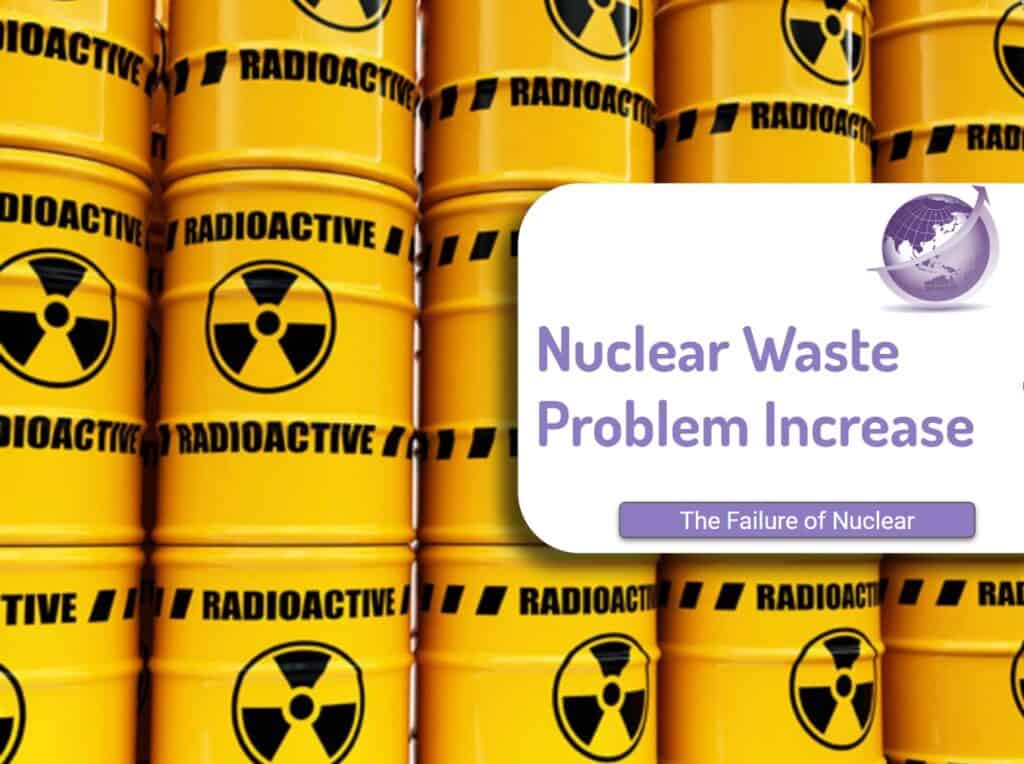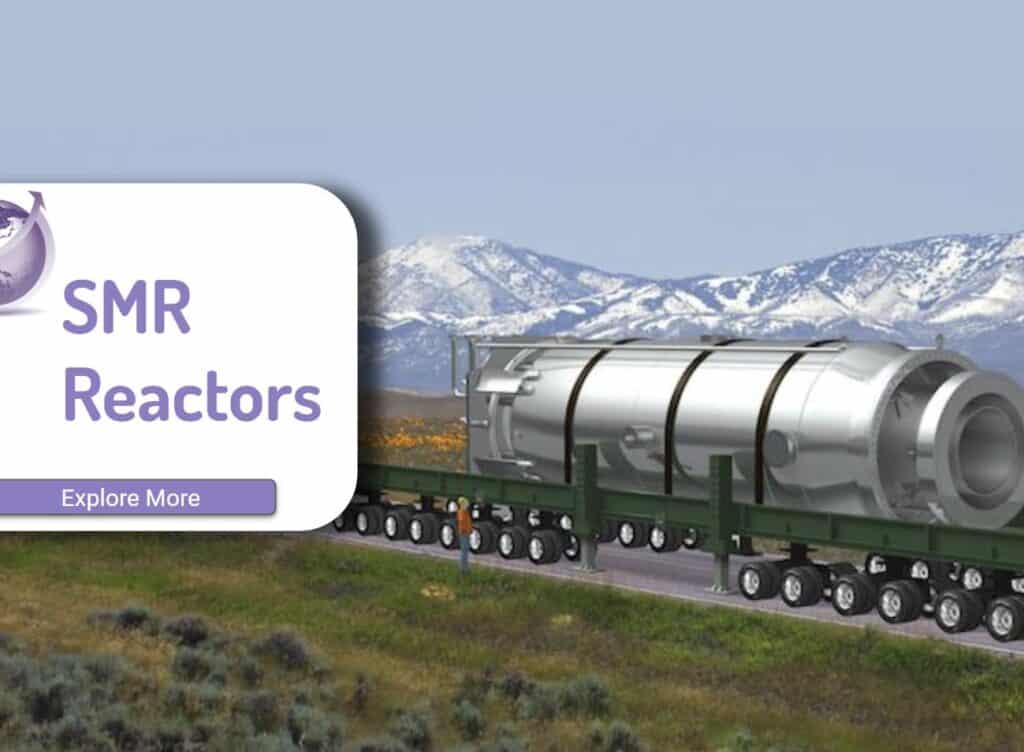The nuclear waste problem is growing. The scale is not recognised by ill-informed nuclear proponents or deceived by nuclear advocates who trivialise the biggest, and increasing problem. Renewable energy can meet much of the world’s demand for energy by 2030. By 2025 renewable energy will be well on the way.
But many think nuclear is the solution to a low emissions power generation future. Less than 415 operating nuclear reactors provide less than 10% of the global energy supply. The majority are decades old, failing, and will need replacing. Small nuclear reactors (<300 MW) are proposed but a study showed waste was up to 9 times more, and toxicity at least double.
Scale of the Nuclear Waste Problem
- Quantity (250,000 tonnes) at about 2kg per person per year. About 22,000 t is hazardous
- 14 countries across the world.
- Stability of storage site
- Radioactivity for 48,000 years (half life of uranium-235 and plutonium-239 is 24,000 years)
- Cost of storing it all, according to GE-Hitachi, is more than $100 billion, (discounting China, Russia, and India).
Radioactive isotopes eventually decay, or disintegrate, to harmless materials. Some isotopes decay in hours or even minutes, but others decay very slowly. Strontium-90 and cesium-137 have half-lives of about 30 years (half the radioactivity will decay in 30 years). Plutonium-239 has a half-life of 24,000 years. Waste from power plants will last more than 10,000 years with radiation about the same as the originally mined uranium ore.
Very few countries have found ways to store waste acceptable to the environment and population. Mostly waste is stored on site. Iceland is one country that has determined site, process and economics for the next 100,000 years. (Science Article) But they raise the question – will it survive 100,000 years? Spent fuel rods from Olkiluoto’s nuclear power plants cool off for several decades in interim storage pools before final burial at Onkalo.
Waste remains an unsolved problem
USA Waste
- In the U.S. alone, commercial nuclear power plants have produced more than 88,000 metric tons of spent nuclear fue. They have substantial volumes of intermediate and low-level radioactive waste.
- Spent fuel, the most highly radioactive waste, will have to be isolated in deep-mined geologic repositories for hundreds of thousands of years.
- The USA has no program to develop a geologic repository.
- The USA has spent decades and billions of dollars since 1987 on the Yucca Mountain site in Nevada.
- Spent nuclear fuel is currently stored in pools or in dry casks at reactor sites
- Spent fuel accumulate at a rate of about 2,000 metric tonnes per year.
- The Biden administration is launching a $6 billion effort to rescue nuclear power plants at risk of closing. They cite the need to continue nuclear energy as a carbon-free source of power that helps to combat climate change. (CBS News).
- An example recently is that the State of Texas just voted to stop creating a further waste site. A month later, the Federal Govt enacted a law to store nuclear power waste in Texas – similar to existing systems.
UK Waste
- The £163 billion problem of how to safely dispose of vast volumes of radioactive waste created by the last British atomic energy program remains unsolved.(see The Guardian).
- Currently stores its 133,000 m3 of radioactive waste above ground. The quantity is projected to swell to more than 4 million cubic metres in future.
- In 2022 the cost of new UK underground nuclear waste facility doubled to £53 billion.
- A larger volume of waste and ‘more realistic’ scope of costs has resulted in a bigger price tag for building and operating a long-term underground storage facility for radioactive waste. (New Scientist)
Australia
- Australia has been trying to establish a site – even for medical nuclear waste and recent efforts are now in court.
France
- France with 59 nuclear reactors produces more nuclear waste per-capita than any other country.
- With almost 72 per cent of its electricity coming from nuclear energy—the most in the world—it generates 2 kilograms of radioactive waste per person each year.
- Following recycling operations, 96% of spent nuclear fuel (95% uranium + 1% plutonium) can be reused to manufacture new fuel, which will then supply more electricity in turn.
- High-level radioactive waste (4%) is vitrified, then conditioned in stainless steel canisters and stored at the La Hague site, pending disposal. No solution for the steel canisters has been found.
SMR Nuclear Reactors
A recent Stanford-led article reported on research published in PLOS found small modular reactors (SMR) will exacerbate the challenges of highly radioactive nuclear waste. The nuclear industry is developing small modular reactors that generate less than 300 megawatts of electric power and can be assembled in factories. As discussed in this article on SMRs, this is unlikely and is a myth.
Our results show that most small modular reactor designs will actually increase the volume of nuclear waste in need of management and disposal, by factors of 2 to 30 for the reactors in our case study,. These findings stand in sharp contrast to the cost and waste reduction benefits that advocates have claimed for advanced nuclear technologies.”
Lead author Lindsay Krall, a former MacArthur Postdoctoral Fellow at Stanford University’s Center for International Security and Cooperation (CISAC).
The study concludes that, overall, small modular designs are inferior to conventional reactors with respect to radioactive waste generation, management requirements, and disposal options.
One problem is long-term radiation from spent nuclear fuel. The research team estimated that after 10,000 years, the radiotoxicity of plutonium in spent fuels discharged from the three study modules would be at least 50% higher than the plutonium in conventional spent fuel per unit energy extracted.
Destruction by Laser Transmutation
Nobel Laureate physicist Gérard Mourou mentioned in his wide-ranging Nobel acceptance speech that lasers could cut the lifespan of nuclear waste from “a million years to 30 minutes”, using fast pulse lasers. There is a project that “may” within 10 years operate. Don’t hold one’s breath as there are lots of challenges.
“Take the nucleus of an atom. It is made up of protons and neutrons. If we add or take away a neutron, it changes absolutely everything. It is no longer the same atom, and its properties will completely change. The lifespan of nuclear waste is fundamentally changed, and we could cut this from a million years to 30 minutes!
Contrarian View By Replanet Group
Nuclear waste could generate up to millennia of zero-carbon electricity for Europe if it were recycled and repurposed as fuel for advanced nuclear reactors, according to the environmental campaign group RePlanet and reported here in Energy Monitor.
Spent nuclear fuel, the most radioactive part of nuclear waste, could be reused in advanced nuclear plants known as ‘fast reactors’ to create between 600 and 1,000 years of carbon-free electricity for the EU, according to the research. A fast reactor is one in which the fission chain reaction is sustained by fast neutrons (carrying energies above 1 MeV or greater), as opposed to slow thermal neutrons used in thermal-neutron reactors.
Instead of being buried in deep geological repositories, the spent fuel could be maintained in an accessible form and used to power the clean energy transition, argues the ‘What a Waste’ campaign. They claim while the economics of fast reactors are currently unproven, if resources currently intended for deep geological disposal of spent fuel were diverted instead into a fast reactor programme that would enable the re-use of that fuel, this would turn a burden into a useful part of a legitimate circular economic activity,” the authors write in the report.
There is only 1 problem. Fast breeder reactors costs are at least double.









